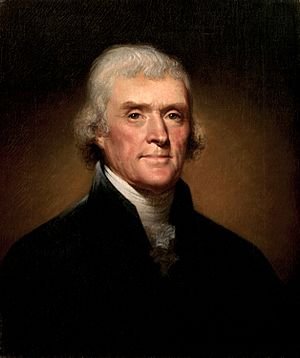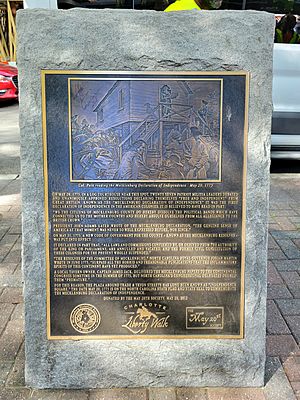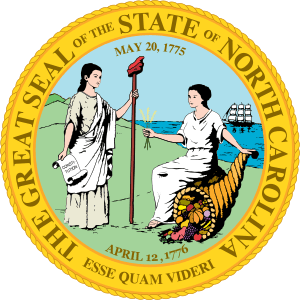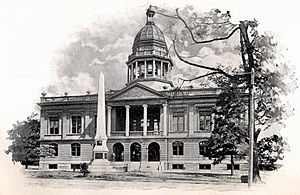Mecklenburg Declaration of Independence facts for kids

The Mecklenburg Declaration of Independence is a document that was published in 1819. It claimed to be the very first declaration of independence made in the Thirteen Colonies during the American Revolution. This was supposedly signed on May 20, 1775, in Charlotte, North Carolina. A group of citizens from Mecklenburg County were said to have declared independence from Great Britain. This happened after they heard about the battle of Lexington.
If this story is true, the Mecklenburg Declaration came out more than a year before the official United States Declaration of Independence. However, people have questioned if the Mecklenburg Declaration is real ever since it was published. This was 44 years after it was supposedly written. There is no clear proof that the original document ever existed. Also, no mention of it has been found in newspapers from 1775.
Most historians believe the Mecklenburg Declaration of Independence is not accurate. They think it's a mistaken version of a real document called the Mecklenburg Resolves. These Resolves were a set of strong statements passed on May 31, 1775. But they were not a full declaration of independence. The text of the Mecklenburg Resolves was lost after the American Revolution. It was only found again in 1838. Historians think the Mecklenburg Declaration was written around 1800. Someone tried to remember the Mecklenburg Resolves and wrote them down. This person might have mistakenly thought the Resolves were a declaration of independence. So, they rewrote them using words from the United States Declaration of Independence.
However, some people believe that both the Mecklenburg Declaration and the Mecklenburg Resolves are real. The early government of North Carolina believed the Mecklenburg Declaration was true. They thought North Carolinians were the first Americans to declare independence. Because of this, both the seal and the flag of North Carolina show the date of the declaration. A holiday called "Meck Dec Day" is celebrated on May 20 in North Carolina. It is no longer an official holiday, though.
Contents
First Publication of the Declaration
The Mecklenburg Declaration of Independence was first published on April 30, 1819. It appeared in an article by Joseph McKnitt Alexander. This article was in the Raleigh Register and North Carolina Gazette newspaper in Raleigh. The newspaper editor wrote that many readers probably didn't know that Mecklenburg County citizens had declared independence. This was more than a year before the U.S. Congress did.
According to Alexander, his father, John McKnitt Alexander, was the clerk at a meeting. This meeting happened in Charlotte on May 19, 1775. Each local army group, called a militia, in Mecklenburg County sent two people to the meeting. They met to talk about the problems between the British Empire and the American colonies.
Relations between the colonies and Britain were very bad, especially in Boston, Massachusetts. This was after the British Parliament passed the Coercive Acts in 1774. During the meeting in Mecklenburg County, the delegates heard official news. The battle of Lexington had happened in Massachusetts one month earlier. Joseph McKnitt Alexander wrote that the delegates were very angry. They passed several resolutions unanimously around 2:00 a.m. on May 20.
These resolutions stated that anyone supporting Britain's invasion of their rights was an enemy. They declared that the citizens of Mecklenburg County were breaking ties with the British Crown. They said they were a free and independent people. They also decided that all former laws would still be followed, but without British authority. Finally, they said that military officers would keep their roles. All delegates would become civil officers to keep peace and spread the love of country.
A few days later, Captain James Jack of Charlotte was supposedly sent to the Continental Congress in Philadelphia. He carried a copy of these resolutions. He also had a letter asking the North Carolina congressmen to get Congress to approve them. The North Carolina delegates in Congress told Jack that they supported the actions. However, they felt it was too early to discuss a declaration of independence in Congress.
Alexander wrote that the original documents were destroyed in a fire in 1800. But he said his article was written from a true copy of the papers left by his father. His father had passed away.
Was Thomas Jefferson Skeptical?

The 1819 article about the Mecklenburg Declaration of Independence was printed in many newspapers. People quickly noticed something important. Even though the Mecklenburg Declaration was supposedly written in 1775, it had very similar phrases to the 1776 United States Declaration of Independence. For example, both used phrases like "dissolve the political bands which have connected" and "absolve ourselves from all allegiance to the British Crown."
This led to a big question: Did Thomas Jefferson, who wrote most of the American Declaration of Independence, copy from the Mecklenburg Declaration?
John Adams, who was also old and retired in 1819, wondered the same thing. He had never heard of the Mecklenburg Declaration before. He thought Jefferson must have copied it. Adams had helped Congress declare independence in 1776. But he felt Jefferson got most of the credit for writing the famous document. So, Adams was happy about the Mecklenburg Declaration. He thought it showed Jefferson wasn't completely original. Adams sent the article to Jefferson to get his thoughts.
Jefferson replied that he, too, had never heard of it. He found it strange that historians of the American Revolution had never mentioned it. He also found it suspicious that the original was lost in a fire. And most of the people who saw it happen were now dead. Jefferson said he couldn't be sure it was fake. But he would believe it was fake until there was strong proof it was real.
Adams agreed with Jefferson. He then sent Jefferson's letter to a newspaper editor. The newspaper expressed doubts about the Mecklenburg Declaration. In response, North Carolina Senator Nathaniel Macon and others gathered stories from people who claimed to have seen the events. These older witnesses didn't agree on every detail. But they generally confirmed that a declaration of independence had been read in Charlotte. They weren't all sure about the exact date. Most importantly, 88-year-old Captain James Jack was still alive. He confirmed he had delivered a declaration of independence to the Continental Congress in May 1775. For many, this seemed to prove the Mecklenburg Declaration was real.
Who Were the Possible Signers?
After the Mecklenburg Declaration was published in 1819, supporters made a list of men they thought had signed it. William Polk said his father, Thomas Polk, read the Declaration to the public. He listed 15 delegates who were there. Other people gave different names. In 1831, the North Carolina government published a list of 26 delegates. Eventually, supporters agreed on a list of 27 or 28 men who supposedly signed the document.
Most of these supposed signers were Scots-Irish Presbyterians. Many early supporters of the Declaration's truthfulness were also Scots-Irish Presbyterians. Many of the supposed signers were related. Their families were among the strongest defenders of the Declaration.
Modern historians point out that the story of the 1775 signing only appeared in 1819. There is no proof from 1775 that a signing happened. Also, John McKnitt Alexander did not mention a signing in his notes. As far as we know, none of the "signers" ever claimed to have signed the Mecklenburg Declaration.
People who saw the 1775 meeting gave different accounts of who did what. John McKnitt Alexander wrote that he was the secretary. But others remembered Ephraim Brevard as the secretary. Alexander wrote that his relative Adam Alexander ordered the meeting. But William Polk and others said Thomas Polk called the meeting. Abraham Alexander is said to have led the meeting.
New Discoveries Change the Debate
In 1838, the argument for the Mecklenburg Declaration's authenticity faced a big challenge. That year, an archivist named Peter Force was looking at old newspapers from 1775. He found a shorter list of resolutions adopted in Mecklenburg County on May 31, 1775. These were different from the Mecklenburg Declaration of May 20.
Then, in 1847, the full text of these Mecklenburg Resolves was found in a South Carolina newspaper from June 1775. Unlike the Mecklenburg Declaration, the Resolves were not a full declaration of independence. They also did not have words similar to Jefferson's 1776 Declaration of Independence. The Resolves were strong for their time. But they were similar to other local resolutions passed in the colonies in 1774 and 1775.
The discovery of the Mecklenburg Resolves changed the debate. Now, the question was how there could be two very different sets of resolutions. They were supposedly adopted in Charlotte only eleven days apart. How could citizens declare independence on May 20, then meet again on May 31 to pass less revolutionary resolutions?
Why Some Doubt the Declaration
Those who doubted the Mecklenburg Declaration believed it was a flawed version of the real Mecklenburg Resolves. This idea was first suggested in 1853 by Charles Phillips. He was a professor at the University of North Carolina at Chapel Hill. He concluded that John McKnitt Alexander had admitted to rewriting the Mecklenburg Declaration from memory in 1800.
In 1906, William Henry Hoyt published a detailed study. Many historians see this work as the final proof against the Mecklenburg Declaration. Hoyt argued that after the original Resolves were destroyed in a fire in 1800, John McKnitt Alexander tried to rewrite them from memory. Alexander made some rough notes. These notes suggest they were written after the 1800 fire. Like some people at the time, Alexander mistakenly remembered the strong Mecklenburg Resolves as a true declaration of independence. This mistake led Alexander, or another writer, to use words from Jefferson's famous Declaration of Independence. This happened when the Mecklenburg Declaration was written from Alexander's notes. The eleven-day difference in dates (May 20 and May 31) might have come from confusion about old and new calendar dates.
According to this view, the older witnesses interviewed after 1819 could not truly remember the exact words of a document they heard almost 50 years earlier. They also couldn't remember the exact date. They were led to believe the Mecklenburg Declaration was real because it was published as a true copy. Because the actual Resolves were strong, and British rule in Mecklenburg County had ended in 1775, the witnesses could believe the Resolves were a full declaration of independence. They likely told the truth about what they remembered. But their answers were influenced by the questions asked. Their memories were actually about the lost Mecklenburg Resolves. By the time the real Resolves were found, all the witnesses had died. So, no one could explain the two different sets of resolutions.
Why Some Believe Both Documents Are Real
People who support the Mecklenburg Declaration argue that both the Declaration and the Resolves are real. This argument was developed in the 20th century by Professor Archibald Henderson. He was also from the University of North Carolina. Starting in 1916, he wrote many articles on the topic. Henderson believed that the evidence showed Mecklenburg County adopted two sets of resolutions. He thought the Mecklenburg Declaration was not just rewritten from memory. He also believed the events described in Alexander's 1819 article were mostly correct. His work was supported in 1960 by V. V. McNitt's book, Chain of Error and the Mecklenburg Declarations of Independence.
One strong piece of evidence supporting the Mecklenburg Declaration was found in 1904. It was a diary entry. The entry is not signed or dated. But it seems to have been written in 1783 in Salem, North Carolina. It was written by a merchant named Traugott Bagge. The English translation of his German entry says:
"I cannot leave unmentioned at the end of the 1775th year that already in the summer of this year, that is in May, June, or July, the County of Mecklenburg in North Carolina declared itself free and independent of England, and made such arrangements for the administration of the laws among themselves, as later the Continental Congress made for all. This Congress, however, considered these proceedings premature."
People who doubt the Mecklenburg Declaration argue that this diary entry just means Bagge misunderstood the Mecklenburg Resolves. They say he wrote eight years later and thought they were a declaration of independence. However, Archibald Henderson argued that the entry supported both documents. He said "declared itself free and independent" referred to the Declaration. And "arrangements for the administration of the laws" referred to the Resolves.
What Historians Think Today
The Mecklenburg Declaration of Independence does not get much attention from professional historians anymore. Most historians generally think the document is not real. If it is mentioned in history books, it is usually to say it is false. Professor William S. Powell, in his history North Carolina through Four Centuries (1989), mentions the Mecklenburg Declaration in a doubtful footnote. Professor H.G. Jones, in North Carolina Illustrated (1983), puts quotation marks around the name of the declaration to show doubt. The Harvard Guide to American History (1954) lists the Mecklenburg Declaration under "spurious declarations," meaning fake ones. Pulitzer Prize-winning historian Allan Nevins wrote in 1938 that North Carolina once made schools teach the Mecklenburg Declaration as truth, even though it was clearly shown to be false.

In 1997, historian Pauline Maier wrote that the "Mecklenburg Declaration of Independence" seems unbelievable when compared to other documents from that time. She said it made North Carolinians' reaction to Lexington and Concord seem more extreme than even the people in Massachusetts who were directly affected. She noted that the resolutions of May 31, 1775, which have real evidence, were also strong but still believable.
Even with many historians doubting it, belief in the Mecklenburg Declaration is still important to some North Carolinians. Historian Dan L. Morrill says that it cannot be completely proven fake. Morrill writes, "The dramatic events of May nineteenth and May twentieth could have happened. Ultimately, it is a matter of faith, not proof. You believe it or you don't believe it."
North Carolina has even released a license plate with the words "First in Freedom." It shows the date of the Declaration of Independence, along with the date of North Carolina's supposed declaration. This happened from 1975-79 and again starting in 2015.
How the Declaration is Remembered

The early government of North Carolina believed the Mecklenburg Declaration was real. They thought North Carolinians were the first Americans to declare independence from Britain. Because of this, both the state seal and the flag of North Carolina show the date of the declaration. Coins have been made to celebrate the Mecklenburg Declaration. The story was also printed in elementary school textbooks.
A monument honoring the supposed signers of the declaration was put up in Charlotte on May 20, 1898. A special tablet was placed in the North Carolina State Capitol building on May 20, 1912. In 1881, the state made May 20 a legal holiday to remember the Mecklenburg Declaration. This day is sometimes called "Meck Dec Day." It is no longer an official holiday and is not as widely celebrated as it once was.
Four United States presidents have visited Charlotte to join the Mecklenburg Day celebration. These were William Howard Taft (1909), Woodrow Wilson (1916), Dwight D. Eisenhower (1954), and Gerald Ford (1975). These presidents knew about the debate. So, they usually praised the brave patriots of Mecklenburg County. But they did not specifically say they believed the disputed document was real.
The Mecklenburg Declaration is also mentioned in the motto for Davidson College. This college is located in Davidson in Mecklenburg and Iredell counties. The motto is Alenda Lux Ubi Orta Libertas. This means "Let Knowledge Be Cherished Where Liberty Has Arisen."
Images for kids
-
Reenactor Jim Williams portraying Thomas Polk at the 20 May 2014 Mecklenburg Declaration of Independence Commemoration at Founder’s Square, Charlotte, North Carolina.





